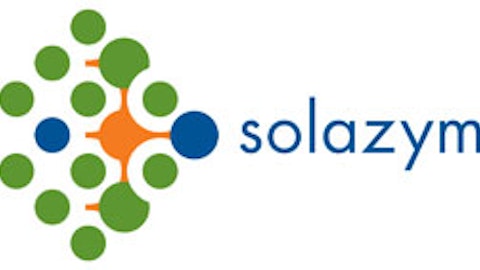The biorefinery is currently employing the second generation of the Amyris’ industrial yeast and using a feedstock of raw sugar, but will switch to cane syrup during this year’s harvest. It is also operating at less than full capacity, but will be running on all cylinders by the second or third quarter. Nonetheless, investors are eagerly awaiting the company’s announcement that it will open the doors to its idled farnesene biorefinery with Antibioticos in Leon, Spain.
Good luck with that. The fallout from the initial production timetable handed to investors years ago, which was proved to be incredibly unrealistic, is still looming over management’s head. Melo refrained from giving a new production timetable for at least another quarter, although it sounds like investors may be left in the dark until the second half of 2013 or later.
He did say that all products sold from here on out will come from internal facilities, as the company is no longer depending on third-party manufacturers. Previously, the company had sourced product from Biomin in Brazil, Antibioticos in Spain, and Tate & Lyle in the United States.
The outlook: products and partners
Amyris products sold at an average price of $8.72 per liter in 2012 as the company focused on higher margin farnesene applications. The number will drop as lower margin products, namely diesel and squalene, increase their presence in the company’s product lineup. Higher volumes and increased efficiency will absorb lower cost, while also enabling positive gross margins as noted above.
Paraiso has been providing customers with test quantities of products for nearly a year now, and management ensured investors that partners are ready to begin incorporating them into their own product lineups. Amyris’ farnesene (Biofene) will be used to provide commercial quantities of liquid rubber for Japan’s Kuraray, base oils for the Novvi joint venture with Cosan Limited(USA) (NYSE:CZZ), and specialty fluids to various other partners in the second half of 2013.
The company’s flavor and fragrance oils, to be sold to Firmenich and Givaudan, have also made strides in their development, which would further enhance Amyris’ financial outlook heading into 2014.
Foolish bottom line
I have followed Amyris closely over the past several years and was even an investor as recently as August. While I am encouraged by the gradually improving picture being painted by the company, I would remain cautious about getting into the company or adding to a position with current developments.
There is still plenty of risk left in the company. If Amyris had a stronger balance sheet, then perhaps I would have a different outlook given its $200 million market cap. One more bad twist in this story and the company will be weakened considerably, unless it can convince its partners for “just one more chance” and more funding.
What do investors want to see? Paraiso needs to ramp up to full production quickly, partners for home and personal care products need to be brought in, and a production timetable needs to be laid out for the shuttered biorefinery in Spain. Then, investors may be able to give Amyris a hard look.
The article Amyris Earnings Show Much Work Remains originally appeared on Fool.com and is written by Maxx Chatsko.
Fool contributor Maxx Chatsko has no position in any stocks mentioned. Check out his personal portfolio, his CAPS page, or follow him on Twitter @BlacknGoldFool to keep up with his writing on energy, bioprocessing, and emerging technologies.The Motley Fool has no position in any of the stocks mentioned.
Copyright © 1995 – 2013 The Motley Fool, LLC. All rights reserved. The Motley Fool has a disclosure policy.


